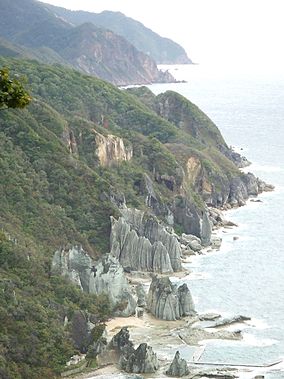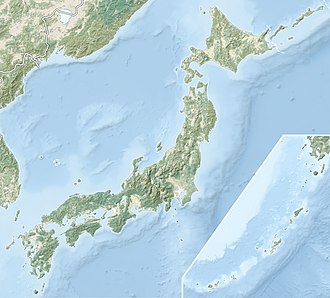Shimokita Hantō Quasi-National Park
From Wikipedia, the free encyclopedia
Shimokita Hantō Quasi-National Park (下北半島国定公園, Shimokita-hantō Kokutei Kōen) is a quasi-national park in the Shimokita Peninsula of Aomori Prefecture in the Tōhoku region of far northern Honshū in Japan. It is rated a protected landscape (category V) according to the IUCN.[2] The park, consists of several discontinuous locations, which include:
- the volcanic peaks and caldera lakes of the Osorezan Mountain Range and surrounding forests.
- Yagen Valley, with its hot springs
- the coastal rock formations of Hotokegaura on the west coast of Shimokita Peninsula
- Cape Ōma, the northernmost point of Honshū
- Cape Shiriya, the northeasternmost point Honshū and the Sarugamori Sand Dunes
- Taijima, an island off the coast of Wakinosawa
| Shimokita Hantō Quasi-National Park | |
|---|---|
| 下北半島国定公園 | |
IUCN category V (protected landscape/seascape) | |
 | |
| Location | Honshū, Japan |
| Nearest city | Mutsu |
| Coordinates | 41°31′33″N 140°55′25″E |
| Area | 18,728 hectares (72.31 sq mi) |
| Established | July 22, 1968 |
| Governing body | Aomori, prefectural governments [1] |
The park also encompasses a portion of the natural habitat of the Japanese macaque. The mountainous interior is forested with Siebold's beech and Nootka cypress, and coastal areas have stands of tilia and oak.[3] The area was designated a quasi-national park on July 22, 1968.
The borders of the park span the municipalities of Mutsu, Higashidōri, Sai, and Ōma.[4]
Like all Quasi-National Parks in Japan, Shimokita Hantō Quasi-National Park is managed by the local prefectural government.[1]
Gallery
See also
References
External links
Wikiwand - on
Seamless Wikipedia browsing. On steroids.




